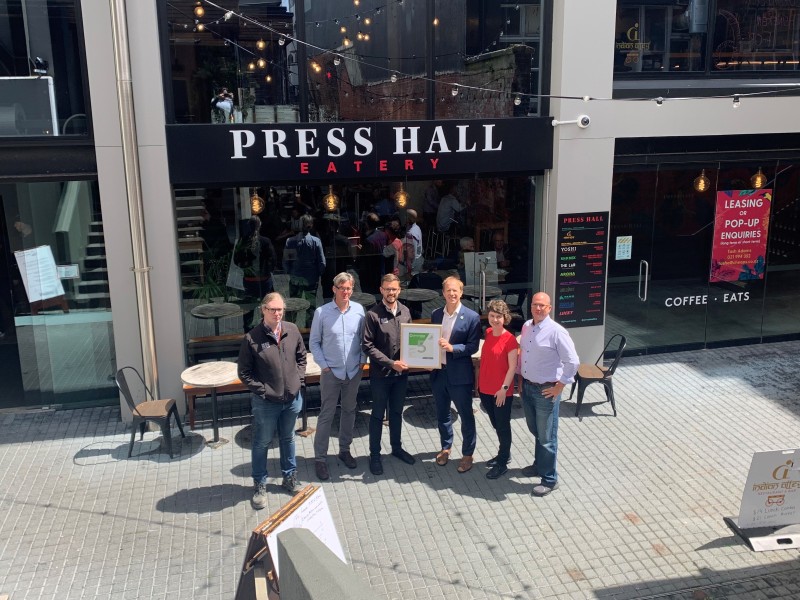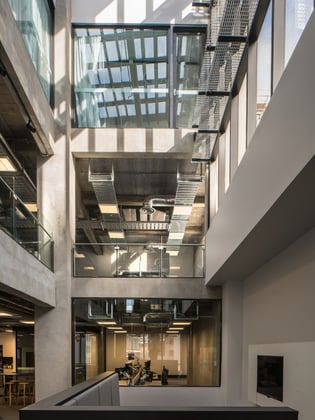A Green Star rating and revitalisation were prime objectives when property owner Cheops Holdings Ltd revamped its iconic inner-city site at 80 Willis Street.
Now complete, the sophisticated overhaul by Cheops and its sister company McKee Fehl Constructors Ltd can tick all the boxes.
Project Snapshot
Owner: Cheops Holdings Limited
Architect: Warren and Mahoney
Service engineer: COR Associates, NME
Main contractor: McKee Fehl Constructors Ltd
GSAP: Jason Quinn, COR Associates
Project status: 2016 to 2018
Project certification: 5 Green Star Office Built V3 (December 2020)
Essentials
What: 80 Willis Street – built in 1923 as the press hall for The Evening Post; now redeveloped as a six-storey building with 4000m² of state-of-the-art offices above Press Hall eateries, a central courtyard and laneway
Tenancy: 3 commercial and 4 hospitality tenancies
Occupancy: Up to 280 people in the building; 100 to 200 people visit Press Hall for lunch daily
Looking for smart, sustainable solutions for heritage redevelopment in the capital is central to Cheops’ strategy and the result at 80 Willis Street demonstrates the company’s pursuit of sustainability at every stage.
The redevelopment of 80 Willis Street is part of a wider $26 million project to transform a cluster of tired and underutilised Wellington Newspapers properties into a dynamic hub. The latest Green Star result follows the impressive 5 Green Star Office Built rating for 22 Boulcott Street.
Matt Fraser, Project Manager at McKee Fehl says 80 Willis Street was rundown and required seismic strengthening, presenting an opportunity for a green, innovative revamp.
“Much of its original form and structure has been preserved and it’s now an A grade mixed-use commercial and retail building. During the project an adjacent dilapidated, low rise property was demolished, opening up the larger complex and allowing space for an access way. This brought greater connection through the building and between two central city streets.”
He says the repurposed site has improved the built environment of the inner city.

The premises now features Press Hall laneway off Willis Street which leads to a central courtyard and stylish mezzanine level accommodating eateries with four levels of offices above.
The refurbishment includes a pedestrian link from Willis Street through to Boulcott Street with lifts connecting to the ground floor of Transpower’s headquarters at 22 Boulcott Street.
Warren and Mahoney principal Ralph Roberts, who lead the 80 Willis Street design process, says it’s been an ambitious project involving “design outcomes which consider a complex balance of construction, seismic strengthening and demolition.”
He says the two large atria and floor to ceiling windows have brought natural light deep into the floor plates of the old printing press building while removing the ceilings has simplified the infrastructure and “showcases the machine-like qualities of modern building services requirements.”
“Press Hall laneway promotes permeability and enhances connectivity between differing ‘neighbourhoods’ and city functions.”

Ralph say right from the start they targeted excellent sustainable outcomes and Cheops’ clear vision propelled the successful 5 Green Star rating.
“It’s great to have such a successful built example of where we must go as an industry. Sustainably verified places are better for people, for business, building owners and of course tenancy occupants. They deliver significant reductions in operating costs, an excellent cultural fit with all users and will be further demanded by generational change in the future,” he says.
“During construction Green Star goals and green thinking were the overarching themes in all our on-site activities,” Matt Fraser says.
Jason Quinn, Project GSAP and Senior Mechanical Engineer at COR Associates, says the project shows what can be done to redevelop an existing building rather than tearing it down.
He says stand-out features include creating jobs by diverting 71 percent of construction and demolition waste from site, cutting out 2500 tonnes of waste to landfill. This was achieved at no cost to the contractor using off-site sorting.
80 Willis Street is an all-electric building (excluding food court use) which Jason says significantly reduces ongoing operational carbon. This is further reduced by the lower electricity demand of the VRF (Variable Refrigerant Flow) heating and cooling system and with heat recovery ventilation of the office levels.

"The all-electric services, VRF and heat recovery system focused the design team on doing the fundamentals correctly rather than adding in gadgets to meet the Green Star rating system.”
The 5 Green Star rating for 80 Willis Street includes 8 innovation points relating to its dynamic laneway, life-cycle assessments - a tool which quantifies the potential environmental impacts of a building through its use of resources and energy over its the lifetime - and market research through a pre/post occupancy survey.
Lead tenant, technology provider Intergen, completed a bespoke workplace fitout over three levels of the building and says its 5 Green Star rated offices are delivering on all fronts.
“It’s fantastic to have a workspace that helps us bring the best out of our people in a space in which they can connect,” says Daniel Kershaw, Intergen General Manager, People Experience.
“We love the vibrancy of Press Hall below and enjoy working in a modern, green, slick environment. Our clients also love to come on site and work with us which speaks volumes.”
Green features include:
|
Technical features include:
|
